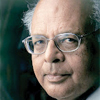The chief economic advisor is not an expert on India, but he brings a fresh outlook
The finance minister recruited his chief economic advisor in Washington; Arvind Subramanian has come on leave from Peterson Institute. The United States has a tradition of millionaires funding academic institutions. Stanford University is an example. It was funded by a man who got rich building railways; the land he gave Stanford made it one of the world’s biggest campuses. Arvind wrote a book some years ago in which he critically reviewed India’s reforms, called ‘India’s Turn: Understanding the Economic Transformation’. Later he wrote a book called ‘Eclipse: Living in the Shadow of China’s Dominance’. The way China has overtaken India in the past two decades, especially in manufacturing, is a matter of concern to many Indians, including those in the current government; the prime minister’s desire to Make in India illustrates this. So his government turned to Arvind, who should know if anyone does how to overtake China.
The hunger for industry makes no sense to an economist. He would believe that every country should specialize in whatever it can produce more cheaply than other countries: it does not matter whether it has an advantage in industry, services, forestry or fishing. So Arvind devoted a chapter in the last Economic Survey to manufacturing vs services. He obviously wrote the chapter, which is replete with equations and references to specialized literature.
He began with two arguments for turning to manufacturing: labour productivity is higher in industry than in the rest of the economy, and it also grows faster. So an economy can raise its growth rate by specializing in industry. But why industry? Services would serve equally well.
Here, Arvind turned to the work of Danny Rodrik, who was his colleague in Harvard 15 years ago. While Arvind was in the International Monetary Fund, Rodrik and he wrote a paper entitled “From ‘Hindu Growth’ to Productivity Surge: The Mystery of the Indian Growth Transition”. The conventional wisdom is that India’s was a sluggish socialist economy until Manmohan Singh, as finance minister, did “reforms” in the early 1990s and turned it into a tiger. Their paper argued that India’s growth accelerated a decade before the reforms, in the early 1980s, and owed nothing to the reforms. It had more to do with relaxation of industrial licensing restrictions: shaken by the oil crisis and its aftermath, the government allowed existing, licensed business enterprises to produce more and diversify. It did not allow more competition; it was more pro-business than pro-market.
For the post-reform period, however, the Economic Survey offers a different hypothesis: that growth of industry and services requires skills in the labour force, and that the share of skilled people in the labour force has grown too slowly. While it supports the idea of Make in India, it argues for skilling India, which also the prime minister has called for.
This analysis is not wrong; it is consistent with the facts the Survey has marshalled. Workers in Indian industry produce little, and it is perfectly possible that their low productivity has something to do with their poor training. But if one wants a reliable conclusion, one must try out alternative explanations; policies should not be based on bivariate correlations, but on factors that give a better explanation than the rest.
A conventional economist would look for an explanation in factor inputs and their productivity. Harry Xiaoying Wu has done enormous work in this field; what emerges from his studies is that Indian industry used capital less efficiently: its capital-output ratios were higher. This, combined with the fact that China saved and invested a higher proportion of its income, is the standard explanation of its better performance.
Wu’s and others’ conclusions about the performance of Indian industry relate only to what are called registered factories, which account for a fraction of Indian industry; most firms are unregistered, and the statistics for them are poor. But labour productivity in unregistered industry is very low; in this respect it is even less efficient than registered industry. Unless it uses capital more efficiently – for which there is no evidence – the standard explanation that Indian industry is inefficient stands. It is a pity that the Survey did not address this explanation, let alone show that its own stands up to facts better.
Arvind Subramanian was brought in quite late last year; it is possible that he did not have the time to study the Indian economy closely enough. He also brought in fresh ideas. But it is more important, especially in the Economic Survey, to be right than bright. Arvind’s predecessor, Raghuram Rajan, had taken in a number of bright research students into the drafting of the Survey with good results; Arvind could try it out. He could also outsource the Survey to the Reserve Bank; it may make it deadly boring, but it will make no mistakes.
(The article appears in the May1-15, 2015)

